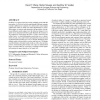Free Online Productivity Tools
i2Speak
i2Symbol
i2OCR
iTex2Img
iWeb2Print
iWeb2Shot
i2Type
iPdf2Split
iPdf2Merge
i2Bopomofo
i2Arabic
i2Style
i2Image
i2PDF
iLatex2Rtf
Sci2ools
CCS
2011
ACM
2011
ACM
Cloak and dagger: dynamics of web search cloaking
Cloaking is a common “bait-and-switch” technique used to hide the true nature of a Web site by delivering blatantly different semantic content to different user segments. It is often used in search engine optimization (SEO) to obtain user traffic illegitimately for scams. In this paper, we measure and characterize the prevalence of cloaking on different search engines, how this behavior changes for targeted versus untargeted advertising and ultimately the response to site cloaking by search engine providers. Using a custom crawler, called Dagger, we track both popular search terms (e.g., as identified by Google, Alexa and Twitter) and targeted keywords (focused on pharmaceutical products) for over five months, identifying when distinct results were provided to crawlers and browsers. We further track the lifetime of cloaked search results as well as the sites they point to, demonstrating that cloakers can expect to maintain their pages in search results for several days on popul...
CCS 2011 | Information Services Web | Information Storage And Retrieval | Search Engine Optimization | Security Privacy |
| Added | 13 Dec 2011 |
| Updated | 13 Dec 2011 |
| Type | Journal |
| Year | 2011 |
| Where | CCS |
| Authors | David Y. Wang, Stefan Savage, Geoffrey M. Voelker |
Comments (0)

